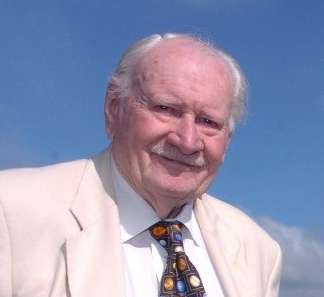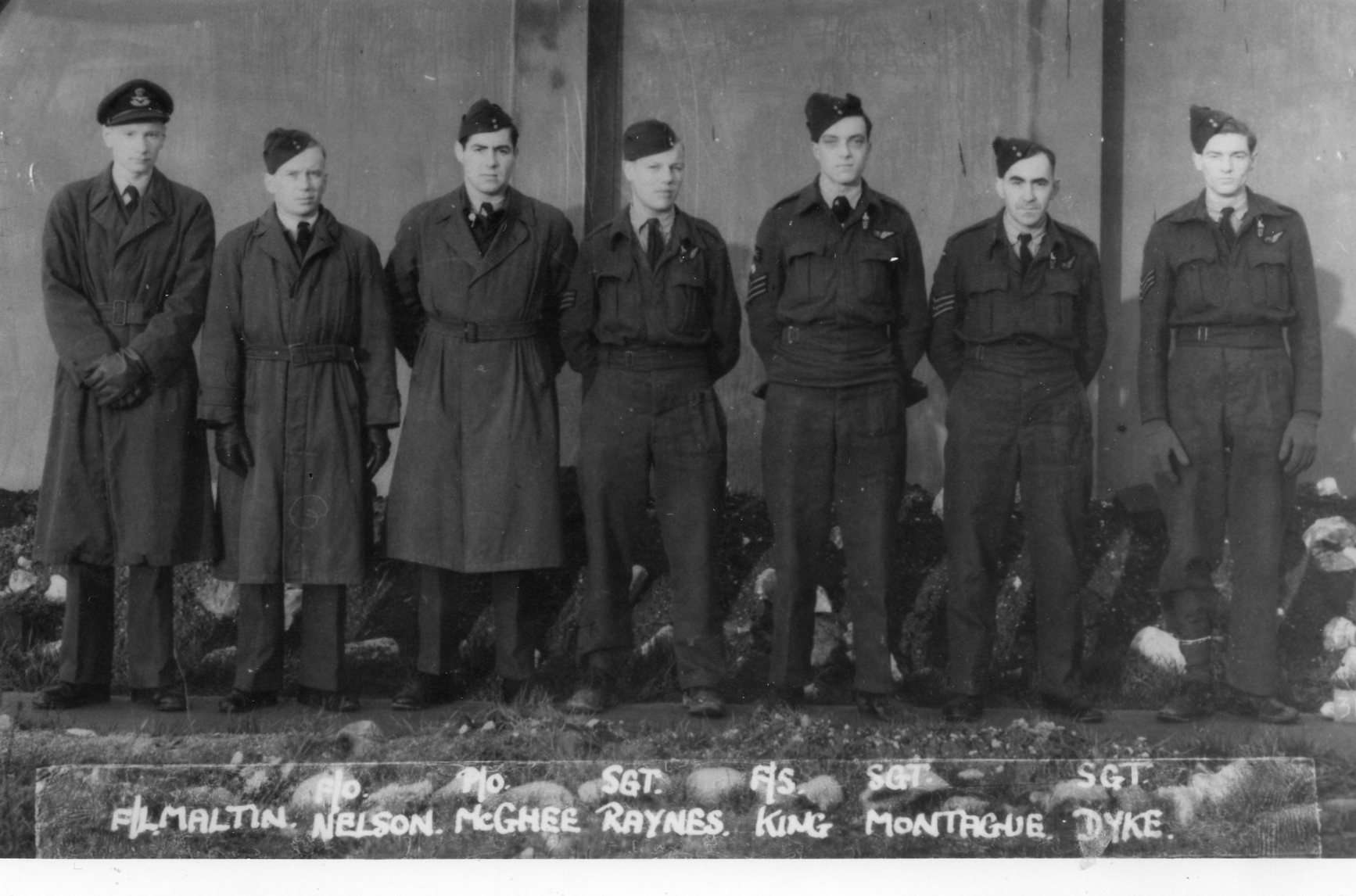
Capt. Michael Francis Aston Maltin, DFC.
A very brave and lovely man

SunInfo is sad to report the death of wartime pilot of Spitfires and then of Lancaster bombers, Captain Michael Maltin DFC. Later a civilian pilot for BOAC and then British Airways and a long time horology and sundial enthusiast, Michael died peacefully in North Woodchester on 25th January 2015, aged 94 years with son Christopher, daughter Elaine and his beloved Vera by his side. Michael was the son of the late Rev Arthur Frank Maltin, former vicar of Stroud and of Amberley and was the much loved husband of the late Christine Maltin. Cherished father, grandfather and great-grandfather. A lovely, unassuming man and a Spitfire fanatic who will be much missed by those who had the privilege to know him.
Michael was DFC gazetted, issue 37088 on the 18 May 1945. The entry reads: "Michael Francis Aston MALTIN (102552), R.A.F.V.R., 550 Sqn". His crew in October 1944 are shown in the photograph below:

Michael's Squadron information may be read here. One sortie in particular is of interest:
Bochum 04 Nov 1944 04 Nov 1944 N
Twenty six aircraft and crews took off at approximately 17.15hrs to attack
BOCHUM in the heart of the Ruhr. Aircraft "G2" (F/O Kennedy) soon after take-off
found that his hydraulics were u/s and his wheels would not retract completely;
thwarted in his efforts to jettison he made a successful landing at Woodbridge
with all his bomb load on board. "E2" (F/O Marriott) found that the rear turret
of his aircraft was u/s with an oil leak and abandoned. The remainder found 9/10
cloud en route, but over the channel this decreased and gradually cleared. The
target was free from cloud, but a certain amount of industrial haze was present.
Markers were punctual and fairly accurate, the target area was kept continuously
marked and the bombing was well concentrated, After the incendiary attack
developed, the whole area rapidly became a mass of fire, visible for
approximately 100 miles and there were a number of impressive explosions. The
ground defences in the target area were reported as moderate, occasionally
becoming intense, with many searchlights in evidence exposing on cone of about
20 or more, the latter were at first ineffective, but later became more
troublesome, several aircraft being coned. Hun night fighters made a strong
reaction and higher flares were seen from the Dutch coast onwards. Many combats
took place in which the following aircraft of 550 Squadron were involved, "B2"
(F/O Whynacht) had 4 encounters and claims to have destroyed 2 aircraft and
damaged another, whilst the other was inconclusive. All these appeared to be
jet-propelled aircraft. No damage or casualties were received. "M" (F/O
McCarthy) and "P" (P/O Franklyn (R)) both opened fire on two jet planes but no
claims were made and the encounters were inconclusive. "V" (F/O Blackler) claims
to have shot down an aircraft believed to be a jet propelled unit. The
appearance of jet propelled and other rocket phenomena is only of recent origin,
and these claims are being further investigated, meanwhile these claims are
accepted with reserve. All our aircraft returned to Base with the exception of
"F" (F/O Ansell) who landed at Manston having received damage to his aircraft
from Flak, the F/Eng (F/S Sythes) receiving wounds in the thigh. Photographs
brought back show extensive fire tracks. Aircraft "F" completed her 100th
operational sortie, a fact that F/L Shaw is very proud of, since he has
completed the major part of his tour in this aircraft. [Ed: Is this last
correct? F/O W J Shaw in "F2" flying not F/Lt "Jock" Shaw in ED905. TBI]
P.R.U cover now confirms the great damage done in this attack - the two main
factories of first priority importance, with extensive blast furnaces, steel
works and rolling mills all making armaments have suffered severely; of the six
main buildings of one of them all are extensively damaged. A third factory
(adjoining the main passenger station which is heavily damaged) manufacturing,
milling and grinding machinery is still smoking and damage appears to be heavy.
Destruction of unidentified industrial and commercial premises, and residential
property is widespread and severe.
Aircraft Deployed
Aircraft Service Number NG120
Crew Details
Returned Primary at 17000ft at 19.36hrs
F/L M F A Maltin (P)
Sgt G N Raynes (F/Eng)
F/O J D Nelson (Nav)
W/O G B McGhee (A/B)
Sgt G King (W/Op)
Sgt V Montague (MU/AG)
Sgt R C Dyke (R/AG)
Michael was born in Chippenham in May 1920. His father was a parson who of course, was required to move with his job. At one point during such moves Michael became a choral scholar at Worcester Cathedral. His father finally settled in Stroud which of course then became the family's base from then on. At age 19 he joined the RAF because he wanted to fly and because at that time they would teach him and after four years, he would get his bonus of £500 and then be able to fly for the nation's then only air carrier, Imperial Airways. The war intervened. In his Spitfire service with the RAF he never actually shot anyone down though he was hit himself and in escaping from one pursuit he did so in such a way that his pursuer lost control and crashed. After 100 operations it was the policy for pilots to be was moved on and so Michael then became an instructor. At this time he got married and moved first to Dalcross in Scotland where he flew a Tiger Moth for the first time. After that he moved to South Cerney where the planes were Oxfords and were used to train pilots from Canada and South Africa in the special navigation techniques that had to be used when flying in Europe; techniques that didn't rely on maps. Whilst at South Cerney Michael tested FIDO - the then new fog landing system. Sometimes on returning to the UK the entire South East could be blanketed in fog and all returning aircraft would be diverted to a FIDO-equipped airfield where they would ignite petrol in trenches on either side of the runway so that the flames could be seen through the thickest fog.
Then, after three and a half years of that, the wartime position changed and his active services were required again. He was posted to Bomber Command where after an initial training on Halifaxes he joined a Lancaster squadron and took part in countless bomber raids including one daytime raid together with aircraft of the US Airforce. After the end of the war Michael joined BOAC as a captain, flying the civilian version of the Lancaster, the Lancastrian.
Its qualities were further extolled in an article in the Express in 2013: "The Lancaster Bomber: that magnificent flying machine" in which is the quote:
"Michael Maltin, a pilot with 550 Squadron, recalled: “You used to treat the Lanc a bit like a Spitfire. You couldn’t break that aircraft. You could pull it about and do steep turns and all that. The Lancaster was magnificent.”
Later, as a pilot with BOAC (later to be BA) it was Michael who, in 1953, took the first commercial jet engined aircraft, the Comet, out of London on its inaugural flight to Tokyo - an aircraft that he found really 'exciting'.
Michael once said in a series of interviews that his one claim to fame was that he had probably flown more behind Merlin engines than any one else in the world. In summarising his life of flying he would say simply that he had always had the best job in the world.
RIP Michael, it is a privilege to have known you.
|
Here BSS Member Gerald Stancey gives us these excellent, interesting insights into Michael and his interests:
|
29/03/2017